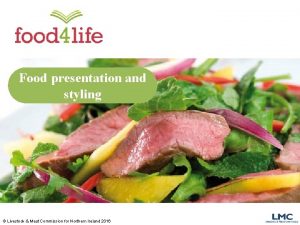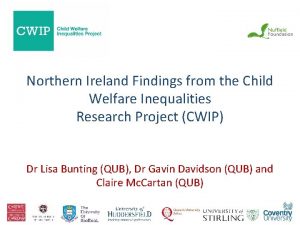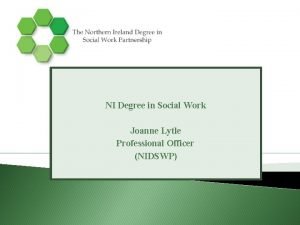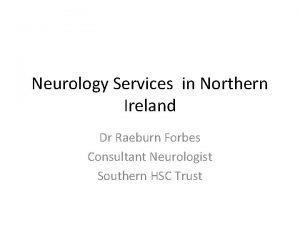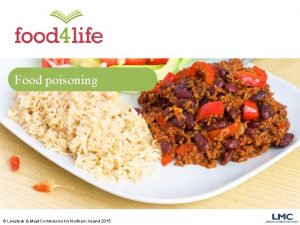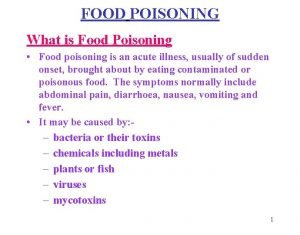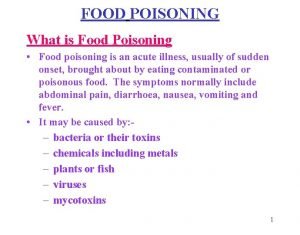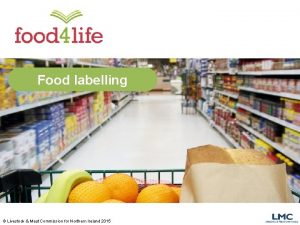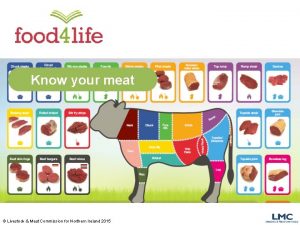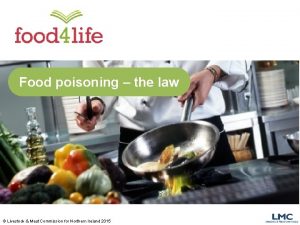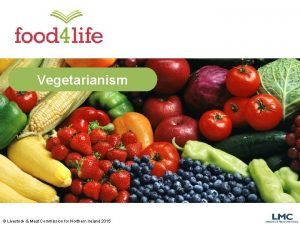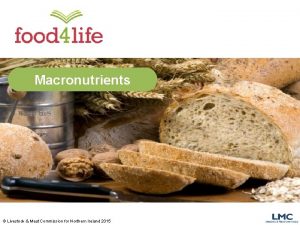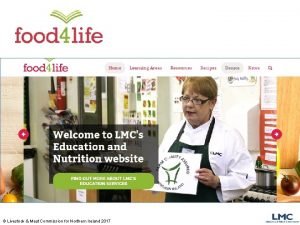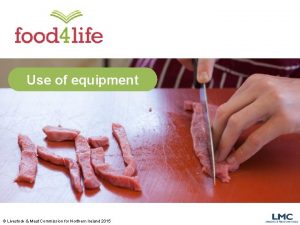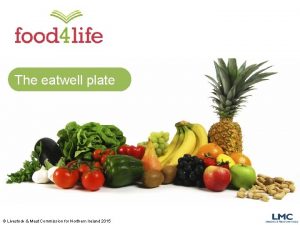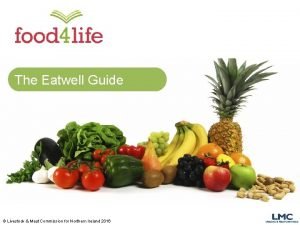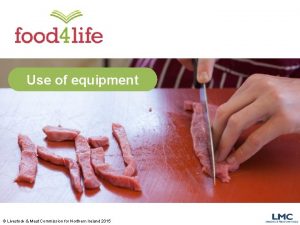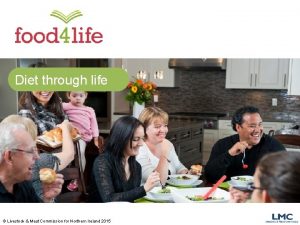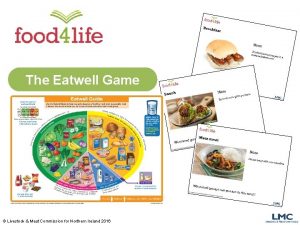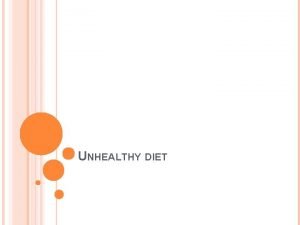Food poisoning Livestock Meat Commission for Northern Ireland





















- Slides: 21

Food poisoning © Livestock & Meat Commission for Northern Ireland 2015

Illness from food Eating or drinking contaminated food can cause injury or illness. Contaminants could include: • Bacteria, viruses or moulds; • Physical hazards such as hair, finger nails, jewellery, plasters and even soil and dirt; • Chemical hazards such as cleaning products, pesticides and fertilisers as well as the incorrect use of additives, e. g. food colours and flavour enhancers. © Livestock & Meat Commission for Northern Ireland 2015

Bacterial contamination Bacteria present in food is the most common cause of food poisoning. However, not all bacteria is harmful as bacteria is necessary for: • Food production such as bread, yogurt and cheese; • Breaking down foods and absorbing nutrients in the gut; • Sewage treatment; • Medicine, e. g. penicillin. © Livestock & Meat Commission for Northern Ireland 2015

Bacteria The harmful bacteria that cause food poisoning are known as pathogenic bacteria (or ‘disease causing’). Sources of contamination include raw food; water; soil; people; pests and pets; air, dust and dirt and food waste. Bacteria that cause food to rot and decay are called spoilage bacteria. © Livestock & Meat Commission for Northern Ireland 2015

Illnesses linked to food There are two types of illness from contaminated food. They are: • Food poisoning; • Food-borne illness. Also, a small number of people are also affected by food allergies. © Livestock & Meat Commission for Northern Ireland 2015

Food poisoning is caused by eating food contaminated by: • Pathogenic bacteria that are living on food; • Poisons naturally occurring in foods such as plants and fish, e. g. red kidney beans (dried); • Metals, e. g. the metals from tin cans; • Chemicals, e. g. cleaning chemicals or pesticides and fertilisers It is important to remember that a large number of pathogenic bacteria are needed to cause food poisoning. © Livestock & Meat Commission for Northern Ireland 2015

Food-borne illness Food borne diseases, like food poisoning, are caused by food or water being contaminated. They are not naturally occurring in the food itself. Contamination can take place at any point from farm to fork. Food-borne = viruses, parasites or pathogenic bacteria carried by food or water. Unlike food poisoning, very small numbers of microorganisms that cause food-borne illness are needed to make someone ill. © Livestock & Meat Commission for Northern Ireland 2015

Bacterial food poisoning The most common reasons for food poisoning are: • Food prepared too far in advance and stored at room temperature rather than in a fridge; • Cooling foods too slowly before refrigeration; • Not reheating foods to the correct temperature (at least 75°C in order to destroy food poisoning bacteria); © Livestock & Meat Commission for Northern Ireland 2015

Most common reasons continued • The use of cooked food which is contaminated with food poisoning bacteria; • Undercooking foods; • Not thawing frozen poultry and meat for sufficient time or in the wrong manner, e. g. in a warm kitchen rather than the fridge; • Cross-contamination – the transfer of bacteria from contaminated food or equipment to ready to eat food. © Livestock & Meat Commission for Northern Ireland 2015

Bacterial food poisoning - Salmonella Common Sources The common sources of salmonella food poisoning bacteria are: • • • Raw and undercooked poultry and eggs; Raw and undercooked meat; Flies and other pests; People and animals (in the gut); Sewage and contaminated water. © Livestock & Meat Commission for Northern Ireland 2015

Bacterial food poisoning - Salmonella Symptoms The common symptoms of Salmonella food poisoning are: • Abdominal pains; • Vomiting; • Diarrhoea; • Fever. Onset times – 6 – 48 hours after consumption of contaminated foods. © Livestock & Meat Commission for Northern Ireland 2015

Bacterial food poisoning - Salmonella Methods of control/precautions In order to reduce the risk of Salmonella food poisoning, the following controls should be put in place: • Thoroughly cook food so that it has a core temperature of at least 70°C or is steaming hot; • Keep raw and cooked foods separate – cover foods in the fridge and store raw foods below cooked foods; © Livestock & Meat Commission for Northern Ireland 2015

Bacterial food poisoning - Salmonella Methods of control/precautions continued: • Use different equipment for raw and cooked foods especially raw meat, poultry and fish, e. g. a red board for raw meat; • Thoroughly wash and dry hands regularly but particularly after touching raw meat and poultry and going to the toilet. Ideally use an anti-bacterial soap; • Ensure the water supply is safe. © Livestock & Meat Commission for Northern Ireland 2015

Bacterial food poisoning – Staphylococcus aureus Common sources The common sources of Staphylococcus aureus food poisoning are: • The human body especially the nose, mouth, skin and any cuts or boils; • Cold meats, poultry and dairy products and anything touched by hand, i. e. handled by someone infected with Staphylococcus aureus bacteria; • Untreated or raw milk, e. g. milk that hasn’t been pasteurised to 71. 7°C for at least 15 seconds to kill bacteria and extend its shelf life. © Livestock & Meat Commission for Northern Ireland 2015

Bacterial food poisoning – Staphylococcus aureus Symptoms The common symptoms of Staphylococcus aureus are: • Abdominal pains; • Vomiting; • Low temperature. Onset times – 1 to 6 hours after consumption of contaminated foods. © Livestock & Meat Commission for Northern Ireland 2015

Bacterial food poisoning – Staphylococcus aureus Methods of control/precautions In order to reduce the risk of Staphylococcus aureus food poisoning, the following controls should be put in place: • Effective personal hygiene – anyone handling, preparing or cooking food should keep themselves clean, wash their hands regularly, wear clean clothes and tie long hair up; • Cuts should be covered with a clean, water proof dressing; • Coughing or sneezing over food should be avoided and hands washed after nose blowing. © Livestock & Meat Commission for Northern Ireland 2015

Food-borne illness - Listeria Common sources The common sources of Listeria are: • Soil, water and sewage; • People; • Soft cheeses made from unpasteurised milk such as Brie and Camembert; • Meat pâtés; • Salad vegetables; • Pre-washed salads. © Livestock & Meat Commission for Northern Ireland 2015

Food-borne illness - Listeria Symptoms The common symptoms of Listeria poisoning are: • Mild flu-like illness; • Can cause septicaemia and meningitis in the young and elderly; • Can cause miscarriage and other complications in pregnancy. Onset times – 1 -70 days. © Livestock & Meat Commission for Northern Ireland 2015

Food-borne illness - Listeria Methods of control/precautions In order to reduce the risk of illness from Listeria, the following controls should be put in place: • Always follow ‘use by’ dates; • Pregnant women should avoid foods with a high Listeria risk such as unpasteurised cheeses, pâtés and washed salads; © Livestock & Meat Commission for Northern Ireland 2015

Food-borne illness - Listeria Methods of control/precautions continued: • Thoroughly wash vegetables that are to be eaten raw; • Clean the fridge regularly. Listeria can multiply even at cold temperatures and therefore chilled foods can become a health risk. © Livestock & Meat Commission for Northern Ireland 2015

Acknowledgement For further information, go to: www. food 4 life. org. uk © LMC 2015 © Livestock & Meat Commission for Northern Ireland 2015
 Food presentation is important
Food presentation is important Patron irlandii północnej
Patron irlandii północnej Symbol of northern ireland shamrock
Symbol of northern ireland shamrock Soscare northern ireland
Soscare northern ireland Joanne lytle
Joanne lytle Four parts of ireland
Four parts of ireland Northern ireland official languages
Northern ireland official languages Northern ireland capital
Northern ireland capital River shannon source
River shannon source Catholic vs protestant
Catholic vs protestant Longest river northern ireland
Longest river northern ireland Northern ireland national flower
Northern ireland national flower Mary's meals northern ireland
Mary's meals northern ireland Ni ploughing association
Ni ploughing association Neurologists northern ireland
Neurologists northern ireland Northern ireland national flower
Northern ireland national flower What is geography
What is geography Education welfare officer northern ireland
Education welfare officer northern ireland Floral emblem of england
Floral emblem of england Symbol of great britain
Symbol of great britain What is the national flower of northern ireland
What is the national flower of northern ireland Northern ireland colleges
Northern ireland colleges
